|
You are receiving this email because you signed up for the monthly ASI Newsletter.
If you no longer wish to receive these emails you can unsubscribe here
|
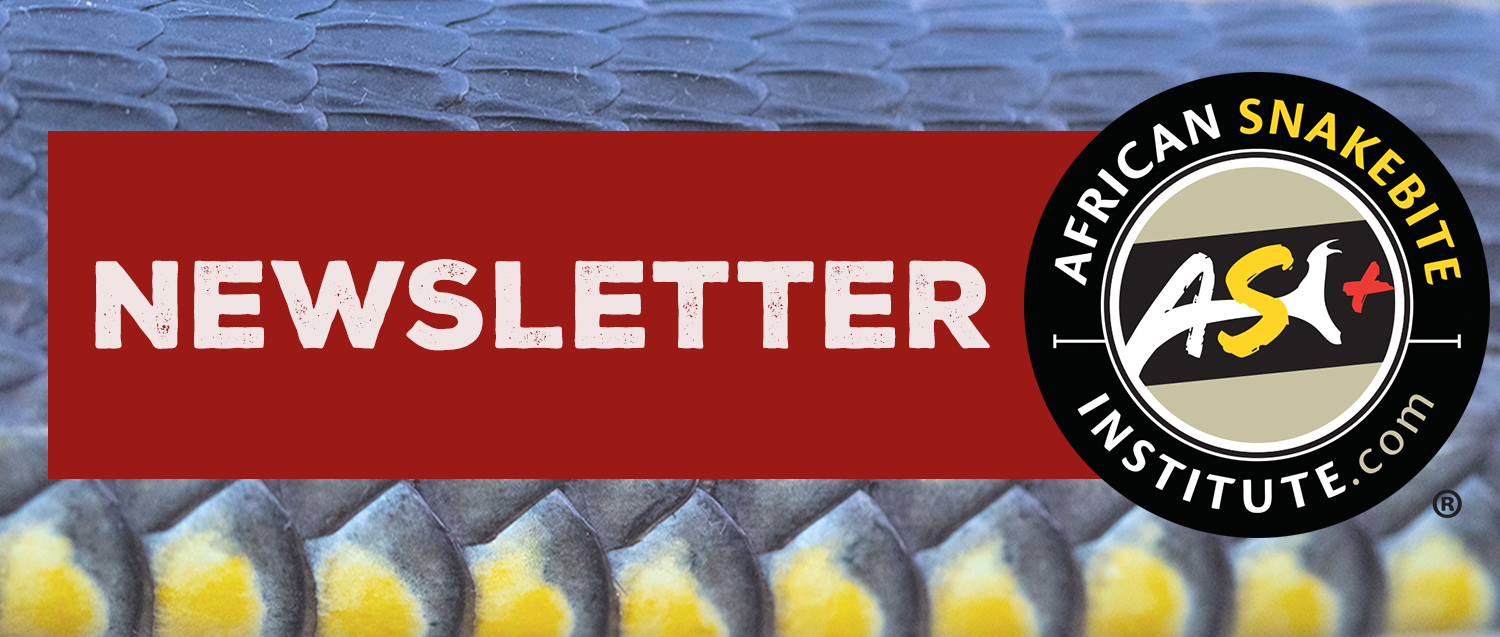 |
|
February 2024 - Vine Snakes of Africa
|
|
|
|
Vine Snakes (previously called Twig or Bird Snakes) are widespread across Africa and are usually found in warm savanna and forested areas. There are currently four species and one subspecies of Vine Snake in Africa. The status and distinguishing features between Oates’ Vine Snake, the Southern Vine Snake and Eastern Vine Snake are not well defined, and identification remains tricky between these three species.
The Latin genus name Thelotornis roughly translates to “a desire to be cylindrical”. They are slender and elongate snakes and very cryptically coloured, usually ash-grey or grey-brown with lighter patches and dark markings across the body. The head is usually green above, notably so in the Usambara and Forest Vine Snake. The Southern, Oates’ and Eastern Vine Snake usually have a green head with a rich brown Y-shape pattern on the crown. The eye of the Vine Snakes has a distinct dark horizontal key-hole shaped pupil.
|
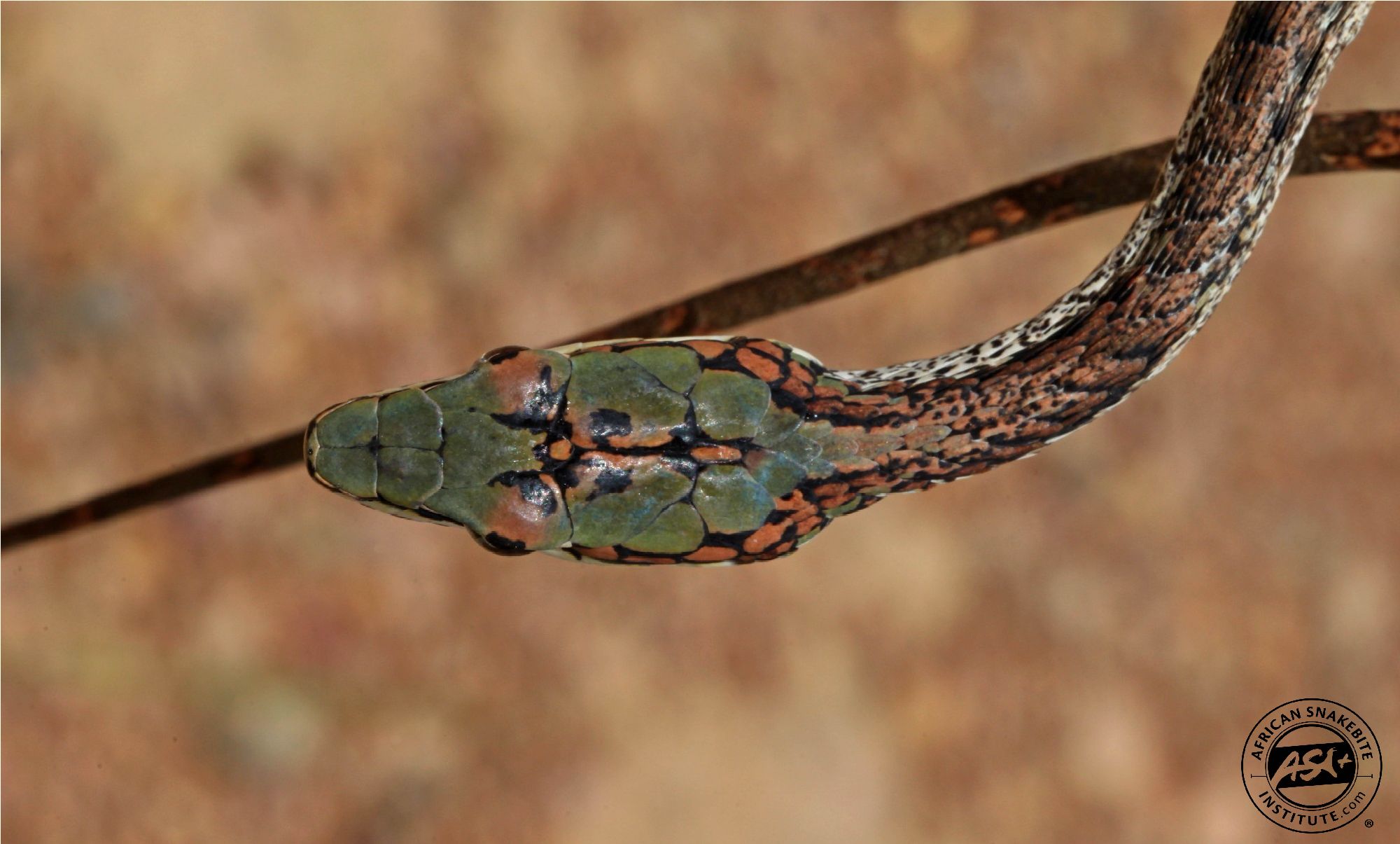 |
|
A Southern Vine Snake (Thelotornis capensis capensis) showing the rich brown Y-shape pattern on the head.
|
|
|
|
Although widespread and abundant, Vine Snakes are rarely seen, relying on their incredible camouflage to avoid detection. These snakes can sit motionless for hours in a bush or tree, waiting for prey to come past.
Prey includes lizards such as Agamas and chameleons as well as a variety of smaller snakes and frogs. They are especially fond of eating the harmless green snakes in the genus Philothamnus. The bright red tongue may be waved around slowly to attract the attention of passing lizards (which probably confuse it for a worm) drawing them closer until they are within striking range. They rarely eat adult birds.
|
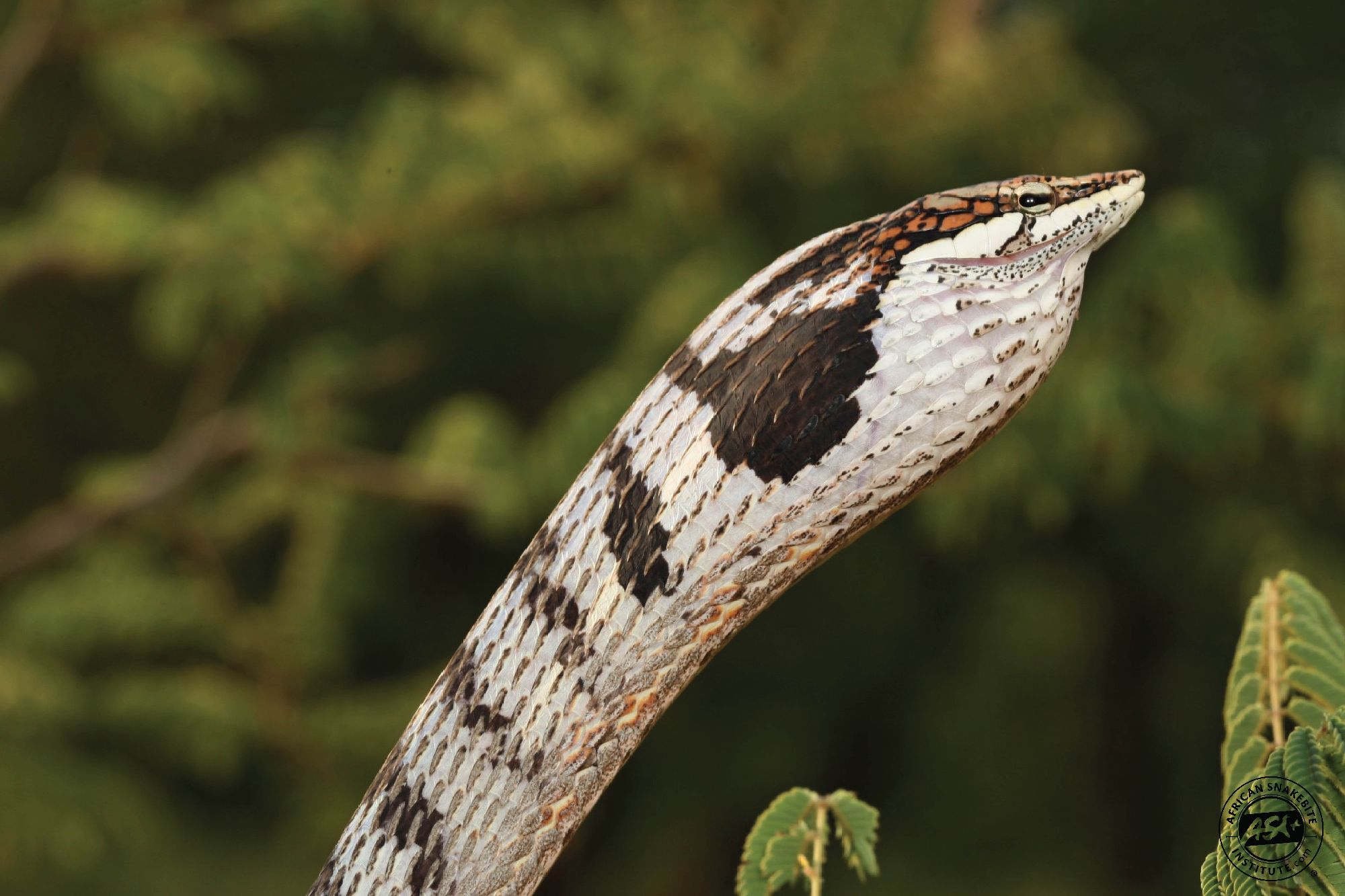 |
|
An agitated vine snake inflating the throat region as a warning.
|
|
If harassed, these snakes may massively inflate the throat region as a warning gesture and are likely to strike out at this stage. The vine snakes may be confused with young Boomslang, which have similar colours in their juvenile phase. The young Boomslang has a more rounded head and massive emerald-green eye.
|
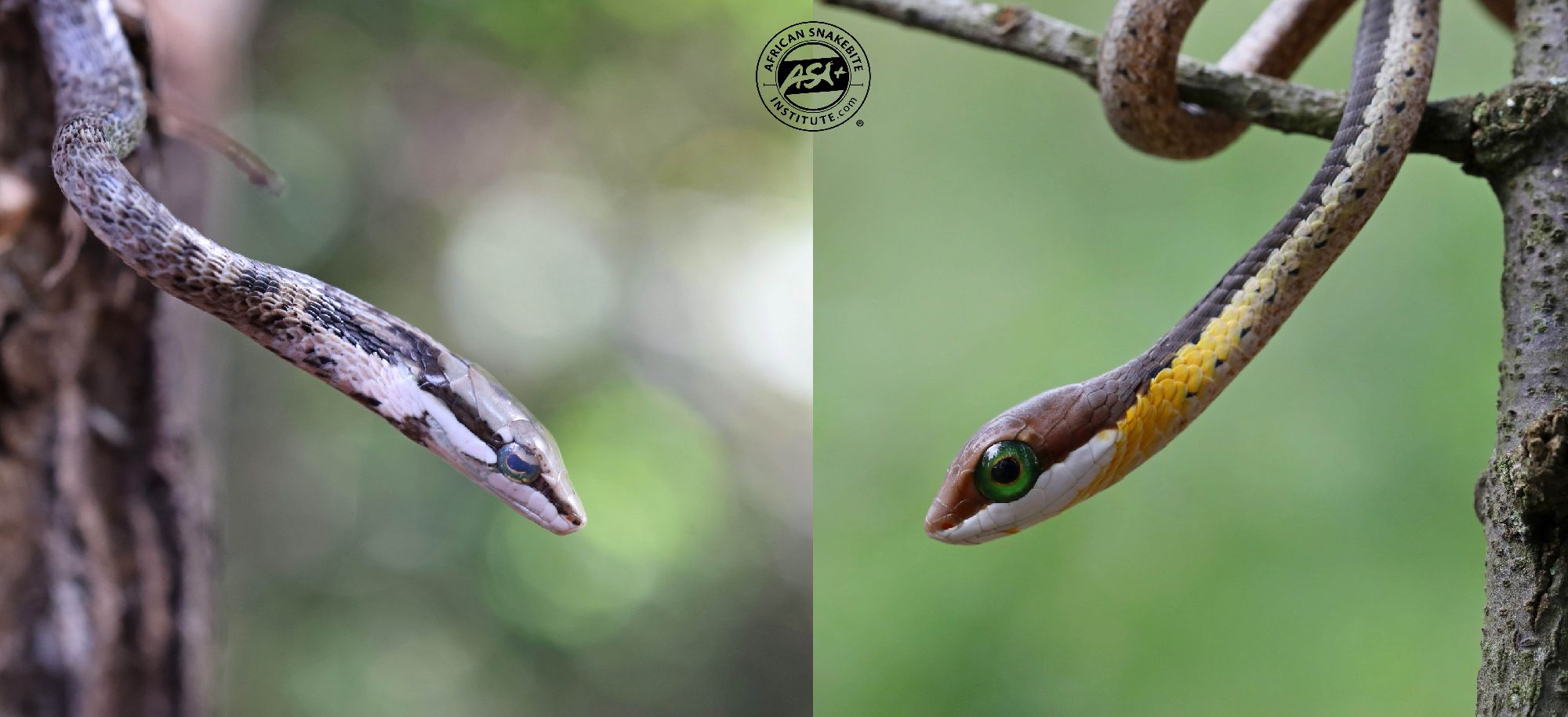 |
|
A young vine snake (left) compared to a young Boomslang (right) showing the more rounded head and large emerald-green eye in the Boomslang.
|
|
|
|
Conservation status of the reptiles of South Africa, Eswatini and Lesotho
now in stock!
A team of reptile experts has written this comprehensive but accessible account for each of the nearly 400 species included in the book, and includes information on the distribution, habitat, threats and conservation measures required for the conservation of each species.
Price R1347.00 including free local shipping.
|
| Order here |
|
|
|
Vine Snakes have a slow-acting haemotoxic venom, very similar to Boomslang venom, but not as potent. Bite victims start haemorrhaging in the body, with blood moving under the skin, dripping out of the nose and mouth and internal bleeding from organs and through the urine. There is no antivenom for this snake and bites are treated symptomatically – usually with blood transfusions or clotting management. We have never had a death in southern Africa from a bite from this snake, however bites from larger species in East Africa have resulted in fatalities. Bites are very rare as this snake is docile and avoids humans. Most bites have been to snake catchers. Below are a few recorded bites:
|
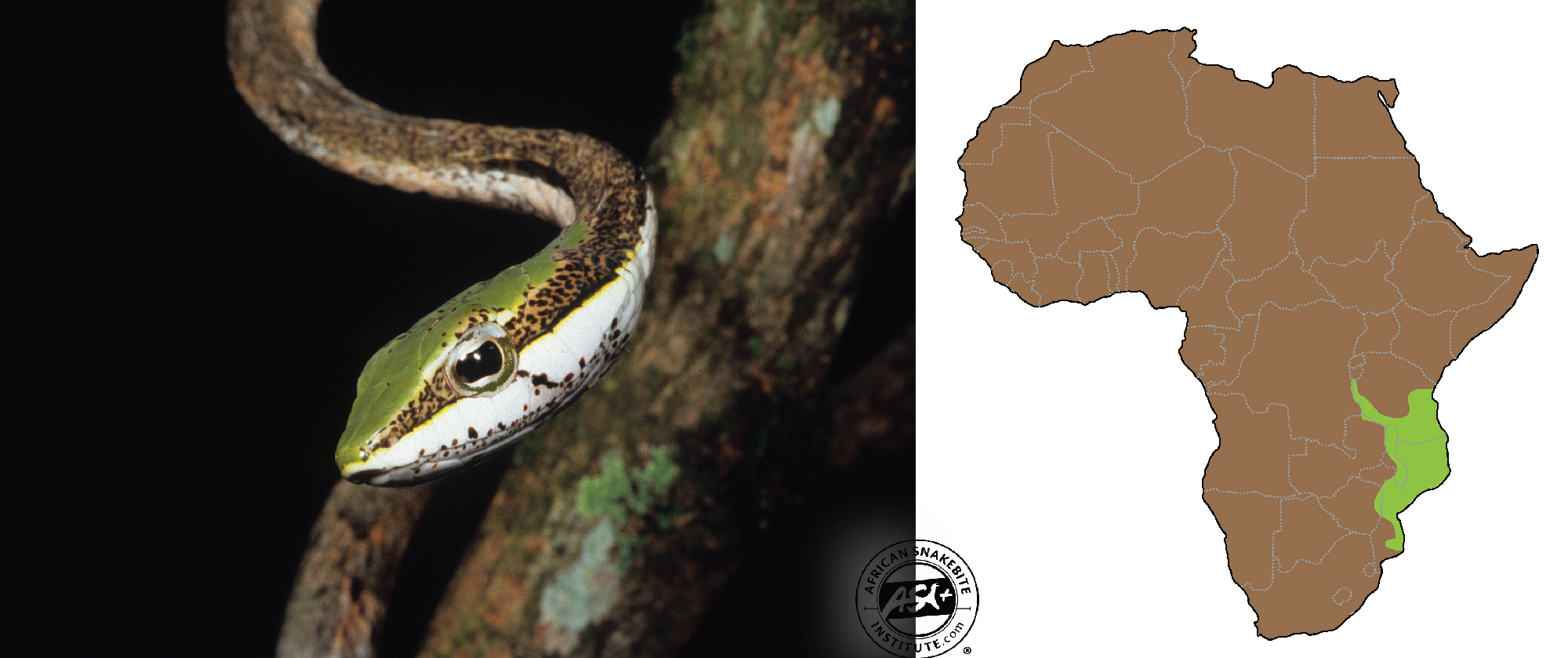 |
|
|
|
The Eastern Vine Snake (Thelotornis mossambicanus) is likely responsible for the first confirmed death of a human by a Vine Snake.
|
|
|
|
The first death recorded by a vine snake bite was in 1953. At this time Vine Snakes were considered harmless and many snake catchers would free handle them. Mr Lock, 35, was a game ranger in Tanzania (still known as Tanganyika back then) who had a special interest in snakes and published some work on the snakes of Tanganyika. He was bitten by one of his Vine Snakes (reported as a Forest Vine Snake -Thelotornis kirtlandii, but more likely an Eastern Vine Snake -Thelotornis mossambicanus - given the location) in his collection after showing the snake to some guests. At the time, it was believed that Vine Snakes were harmless, and Mr Lock didn’t think much of the bite. The next day he started getting ill - headache, diarrhoea, stomach pains and vomiting - but assumed it was from drinking too much the night before. By the second day he started vomiting blood and was taken to hospital. The treating doctor had worked on a gastric ulcer on Mr. Lock two years before and assumed that was the cause of the symptoms. Mr. Lock did not mention the snake bite to the doctor as he was sure it was a harmless snake. Later that night Mr. Lock fell into a coma following violent convulsions and eventually passed away in the early hours of the following morning, 52 hours after being bitten.
The postmortem revealed haemorrhaging in the stomach, spinal fluid and bladder. The patient had kidney (renal) failure and was not passing urine. There was also blood oozing from the mouth and nose, and extensive brain haemorrhaging which likely caused the death.
|
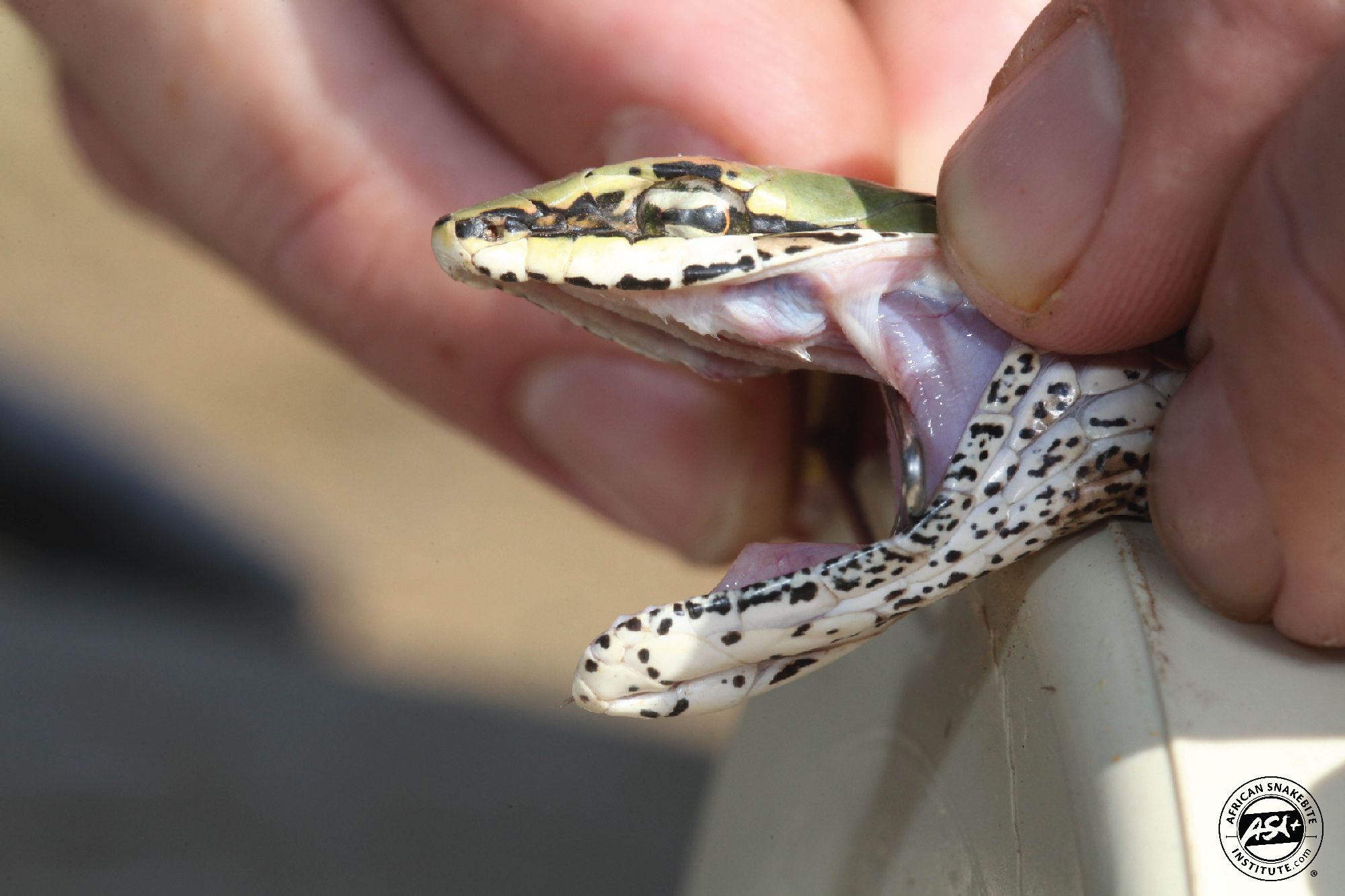 |
|
The small back-fangs of a vine snake.
|
|
|
|
ASI Travellers Snake Tong
The ASI Travellers Snake Tong collapses down to 80 cm and extends to 115 cm. A unique tong design, which doesn't require any pins to hold the trigger in place. These tongs also feature the extended JM jaw lip - great for capturing all snakes, even large ones.
Ideal for travellers - fits into a large suitcase (70 high x 50 wide x 32 deep)
Price 1275.00
|
| Order here |
|
|
|
In 1957, the late Dr Broadley was bitten by a large Oates’ Vine Snake (Thelotornis capensis oatesii) in southern Zimbabwe. The snake chewed on his finger whilst he climbed down the tree and managed to unlatch the snake from his hand and bag it. He noted swelling in the finger and there was blood oozing from the bite marks. By that evening he started oozing blood from scratches on his legs (from climbing the thorn tree) and shaving cuts. By the following day he was still bleeding from the cuts on his legs “The blood was very slow to clot, and I left pools of blood wherever I went”. The bleeding stopped on the third day and the swelling of the hand reduced by the fifth day, and he recovered fully.
Dr Blaylock also received a bite by Oates’ Vine Snake (Thelotornis capensis oatesii) in 1959 in Kariba, Zimbabwe. The snake latched onto the base of a finger and chewed for around 30 seconds before being removed. A headache developed within 30 mins and some swelling on the hand. He injected 5 cc polyvalent antivenom in the hand and 10 cc into the buttocks. None of the antivenoms have been shown to have any effect on the venom of the Vine Snake. Dr Blaylock felt sick and feverish, and started vomiting later that evening. The vomiting continued the next morning, and he was taken to hospital and given a blood transfusion. That evening he started bleeding from cuts and vomited more. He started developing blood blisters on cuts and had painful kidneys and stomach. The injection in the buttocks formed a haemorrhage that took two weeks to subside. Four days after the bite, blood clotting was satisfactory, and the patient was sent home. He still passed some blood in the urine on the fifth day but was fit within a week.
|
 |
|
Oates' Vine Snake (Thelotornis capensis oatesii) has accounted for a number of bites but none have been fatal.
|
|
|
|
Another case in southern Malawi in 1965 was to a 30-year-old male who attempted to catch the snake. The bite resulted in blood oozing from the bite site, small cuts on the hand and out of the mouth. He received two vials of polyvalent antivenom initially (which is ineffective for Vine Snakes) and more when he reached the next hospital plus Vitamin K (which is also ineffective). He developed a patch of clotted blood under the chest muscle and was given two units of blood. His condition deteriorated over the next six days, and he received another six units of blood. Finally on the seventh day he stopped bleeding and started recovering well.
|
 |
|
The Forest Vine Snake (Thelotornis kirtlandii) is largely found in central Africa as well as the forested regions of West Africa. Photo - Richard Mckibbin
|
|
|
|
Another death was recorded in 1978 in a private collection in Germany. The eighty-four-year-old patient spent 18 days in hospital before succumbing to renal failure, swelling of the tissue of the lungs and haemorrhaging. It is uncertain of the exact species but is likely to be the Eastern Vine Snake (T. mossambicanus) or the Forest Vine Snake (T. kirtlandii).
A 13-year-old boy was bitten in Durban in 1980. He received 400ml blood transfusion and showed slowed clotting but no bleeding. He had two episodes of convulsions and a tight chest. He was examined for six days in hospital but was discharged when the platelet levels had returned to normal.
|
 |
|
The Southern Vine Snake (Thelotornis capensis capensis) does not often feature in snakebite incidents.
|
|
Thelotornis capensis oatesii – 1987 – 41-year-old bitten on the wrist whilst moving a vine snake. Bled for the first 30 minutes. Had a headache and started bleeding from old scratches. He was hospitalised and by the next day still oozing blood plus a swollen wrist. Vitamin K injection in the shoulder, which was bruised and oozing blood. He received 6 units of blood on arrival at the hospital and 6 units 4 hours later and again 24 hours later. Bleeding from small wounds stopped after 3-4 days and swelling of the wrist subsided and he was discharged.
A 2003 report of a bite to a dog (8kg pug) by the Southern Vine Snake (Thelotornis capensis capensis) resulted in a nosebleed for four days. No other symptoms were recorded, and the dog made a full recovery.
|
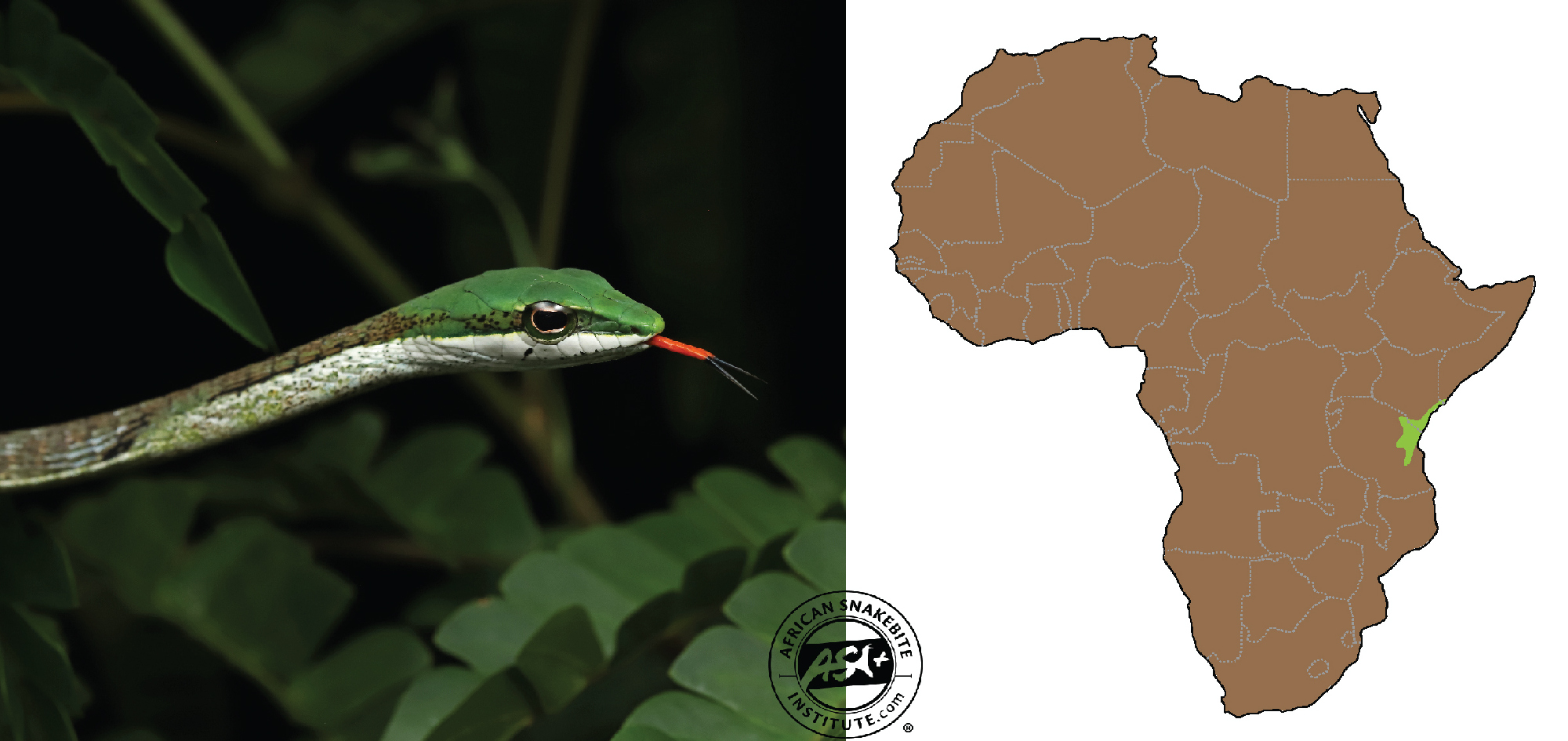 |
|
The Usambara Vine Snake (Thelotornis usambricus) has the smallest range of the vine snakes and no bites have been reported. Photo - Bobby Bok
|
|
Treatment is generally done with blood platelet transfusions and supporting the kidneys. None of the antivenoms produced show any effect against the venom of the vine snakes. Vitamin K injections are not advised. Naturally, vitamin K assists the body with producing clotting factors in the liver. The problem in haemotoxic bites is that it doesn’t matter how much the liver produces, the body uses it all for other processes whilst in shock. Additionally, injections can also cause haemorrhaging in the tissue which is problematic and not ideal during these bites.
Despite being highly venomous snakes, the vine snakes are placid and can be observed from a few meters away in a safe manner. The camouflage is easily appreciated whilst watching this snake as your eyes struggle to identify the body from surrounding branches and twigs. Although a placid snake, it must be treated with caution and bites avoided at all costs. In a case of serious envenomation from this snake there is no guaranteed treatment.
|
|
|
|
One of our best-selling gaiters -
the Budget Snake Resistant Gaiter with Shin guard - are now back in stock!
The outer shell is made from a heavy-duty nylon cordura fabric. Insert panels are made from molded polypropylene panels, for maximum protection.These gaiters include a 3-panel moulded boot cover to ensure foot protection at the ankle.
Price R740.00
|
| Order here |
|
|
|
|
|
WESTERN CAPE
CEDERBERG
Snake Awareness, First Aid for Snakebite and Venomous Snake Handling Course
Date: Wednesday 6 March 2024
Venue: Mount Ceder, Cederberg Western Cape
|
|
|
| Book here |
|
|
|
NORTHERN CAPE
AUGRABIES
Snake Awareness, First Aid for Snakebite and Venomous Snake Handling Course
Date: Friday 15 March 2024
Venue: Augrabies Falls National Park, Northern Cape
|
|
|
| Book here |
|
|
|
NOTHERN CAPE
UPINGTON
Snake Awareness, First Aid for Snakebite and Venomous Snake Handling Course
Date: Saturday 16 March 2024
Venue: Upington, Northern Cape
|
|
|
| Book here |
|
|
|
GAUTENG
PRETORIA
Snake Awareness, First Aid for Snakebite and Venomous Snake Handling Course
Date: Saturday 16 March 2024
Venue: SA Jagters Inyathi Park, Pretoria
|
|
|
| Book here |
|
|
|
GAUTENG
Venomous Snake Handling Bootcamp
Date: Sunday 17 March 2024
Venue: SA Jagters Inyathi Park, Pretoria
|
|
|
| Book here |
|
|
|
WESTERN CAPE
KLAPMUTS
Snake Awareness, First Aid for Snakebite and Venomous Snake Handling Course
Date: Saturday 16 March 2024
Venue:Exotic Animal World, Klapmuts, Western Cape
|
|
|
| Book here |
|
|
|
WESTERN CAPE
KLAPMUTS
Venomous Snake Handling Bootcamp
Date: Sunday 17 March 2024
Venue: Exotic Animal World, Klapmuts, Western Cape
|
|
|
| Book here |
|
|
|
WESTERN CAPE
KLAPMUTS
Kids' Snake Awareness Course
Date: Sunday 17 March 2024
Venue: Exotic Animal World, Klapmuts, Western Cape
|
|
|
| Book here |
|
|
|
|
|
|
|
Johan Marais is the author of various books on reptiles including the best-seller A Complete Guide to Snakes of Southern Africa. He is a popular public speaker and offers a variety of courses including Snake Awareness, Scorpion Awareness and Venomous Snake Handling. Johan is accredited by the International Society of Zoological Sciences (ISZS) and is a FGASA (Field Guides Association of Southern Africa) and SASTM (South African Society of Travel Medicine)-approved service provider. His courses are also accredited by the HPCSA (Health Professions Council of South Africa). Johan is a qualified instructor for the Emergency Care & Safety Institute in Oxygen Administration and Wilderness First Aid and a qualified Basic Life Support instructor.
|
 |
|
Copyright © 2023 African Snakebite Institute, All rights reserved.
Our mailing address is:
admin@asiorg.co.za
Unsubscribe from this list
|
|
|